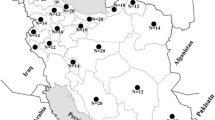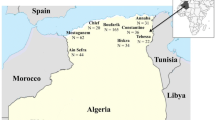Abstract
The genetic diversity of three Iranian honey bee populations (Apis mellifera meda) was studied using morphological and microsatellite loci in south Iran. For this purpose ten morphological characters and five microsatellite loci were studied. Morphometric analysis resulted in a distinct classification of three investigated populations but showed low diversity among them. The grouping results of the diversity study by microsatellite markers were in agreement with the results of morphometry. The cluster analysis showed that the honey bees have clustered together in one group. These populations displayed low variability estimated from both the number of alleles and heterozygosity values. Genetic differentiation within the populations is low and low heterozygosity was also presented between diverse populations. These results indicate the existence of a single population structure. The results of current research confirmed us the previous findings concerning morphological and biochemical indications of uniformity in the honey bee population of the south Iran in spite of the fact that the cities which was studied by us separated from each other by a distance of 500 km.




Similar content being viewed by others
References
Jensen AB, Palmer KA, Boomsma JJ, Pedersen BV (2005) Varying degrees of Apis mellifera ligustica introgression in protected populations of the black honeybee, Apis mellifera mellifera, in northwest Europe. Mol Ecol 14(1):93–106
Woyke J (1976) Population genetic studies on sex alleles in the honeybee using the example of the Kangaroo Island bee sanctuary. J Apic Res 15(3/4):105–123
Woyke J (1980) Effect of sex allele homo-heterozygosity on honeybee colony populations and on their honey production. 1. Favourable development conditions and unrestricted queens. J Apic Res 19(1):51–63
Woyke J (1981) Effect of sex allele homo-heterozygosity on honeybee colony populations and on their honey production. 2. Unfavorable development conditions and restricted queens. J Apic Res 20:148–155
Oldroyd BP, Rinderer TE, Harbo JR, Buco SM (1992) Effects of intracolonial genetic diversity on honey bee (Hymenoptera: Apidae) colony performance. Ann Entomol Soc Am 85(3):335–343
Mattila HR, Seeley TD (2007) Genetic diversity in honey bee colonies enhances productivity and fitness. Science 317(5836):362–364
Ting Ji L, Ling Y, Guohing C (2011) Genetic diversity and population structure of Chinese honeybee (Apis mellifera) under microsatellite markers. Afr J Biotechnol 10(9):1712–1720
Tarpy D (2003) Bet hedging by honey bee queens. Am Bee J 143(12):937–939
Tarpy DR, Seeley TD (2006) Lower disease infections in honeybee (Apis mellifera) colonies headed by polyandrous vs monandrous queens. Naturwissenschaften 93(4):195–199
Palmer KA, Oldroyd BP (2003) Evidence for intra-colonial genetic variance in resistance to American foulbrood of honey bees (Apis mellifera): further support for the parasite/pathogen hypothesis for the evolution of polyandry. Naturwissenschaften 90(6):265–268
Tarpy DR, Page RE Jr (2001) The curious promiscuity of queen honey bees (Apis mellifera): evolutionary and behavioral mechanisms. Ann Zool Fenn 3:255–265
Ruttner F, Tassenocourt L, Louvaux J (1978) Biometrical–statistical analysis of the geographic variability of Apis mellifera L. Apidologie 9(4):363–381
Estoup A, Solignac M, Cornuet J-M (1994) Precise assessment of the number of patrilines and of genetic relatedness in honeybee colonies. Proc R Soc Lond B 258(1351):1–7
Estoup A, Garnery L, Solignac M, Cornuet J-M (1995) Microsatellite variation in honey bee (Apis mellifera L.) populations: hierarchical genetic structure and test of the infinite allele and stepwise mutation models. Genetics 140(2):679–695
Franck P, Garnery L, Solignac M, Cornuet J-M (2000) Molecular confirmation of a fourth lineage in honeybees from Near East. Apidologie 31(2):167–180
Garnery L, Franck P, Baudry E, Vautrin D, Cornuet J-M, Solignac M (1998) Genetic diversity of the west European honey bee (Apis mellifera mellifera and A. m. iberica) II. Microsatellite loci. Genet Sel Evol 30(Supplement):S49–S74
Tahmasbi GH (1996) Morphological and biochemical survey of honey bee (Apis mellifera L.) populations in Iran. Tarbiat Modares University, Tehran
Royan M, Rahim G, Esmaeilkhanian S, Mirhoseini S, Ansari Z (2007) A study on the genetic diversity of the Apis mellifera meda population in the south coast of the Caspian Sea using microsatellite markers. J Apic Res 46(4):236–241
Alpatov W (1929) Biometrical studies on variation and races of the honey bee (Apis mellifera L.). Q Rev Biol 4:1–58
Goetze G (1940) The best bee: methods for selecting bees for (great) length of tongue. Insectes Soc. 3:335–346
Goetze G (1959) Die Bedeitung des Flügelgeäders für die Züchterische Beurteilung der Honigbiene. Zeitscrift für Bienenforschung 4:141–148
Aljanabi SM, Martinez I (1997) Universal and rapid salt-extraction of high quality genomic DNA for PCR-based techniques. Nucleic Acids Res 25:4692–4693
Meixener-Monori B, Kubicek CP, Harrer W, Schreferl G, Rohr M (1986) NADP-specific isocitrate dehydrogenase from the citric acid-accumulating fungus Aspergillus niger. Biochem J 236:549–557
Acknowledgments
We thank the kind beekeepers of Kerman Province, which permitted us to collect the bees from their bee colonies and Dr. Ghasem Mohammadinejad (Shahid Bahonar University of Kerman) for help in statistical analysis. Thanks to Zagros Biotechnology Section of Razi University Incubator for All Supports.
Author information
Authors and Affiliations
Corresponding author
Rights and permissions
About this article
Cite this article
Rahimi, A., Mirmoayedi, A., Kahrizi, D. et al. Microsatellite genetic diversity of Apis mellifera meda skorikov. Mol Biol Rep 41, 7755–7761 (2014). https://doi.org/10.1007/s11033-014-3667-7
Received:
Accepted:
Published:
Issue Date:
DOI: https://doi.org/10.1007/s11033-014-3667-7




